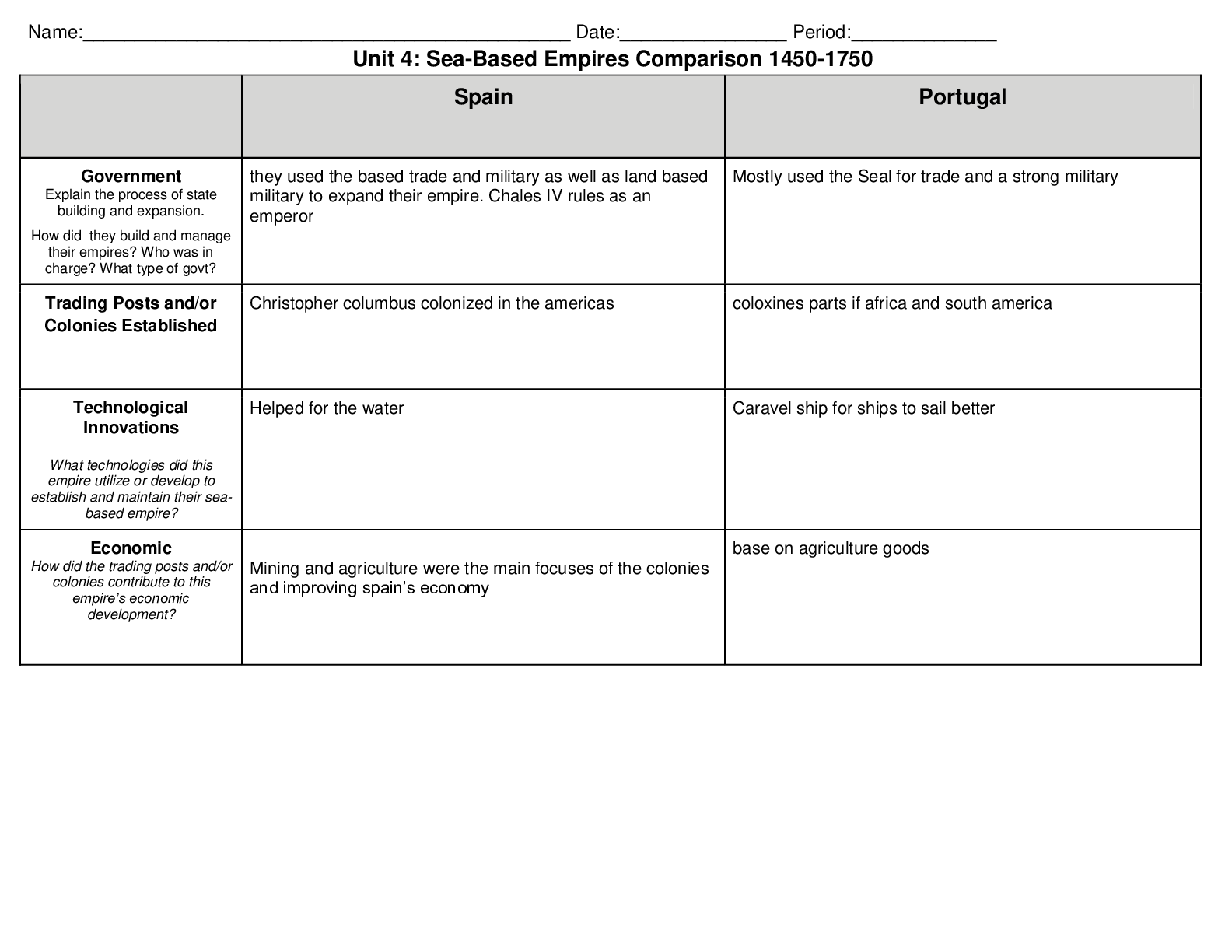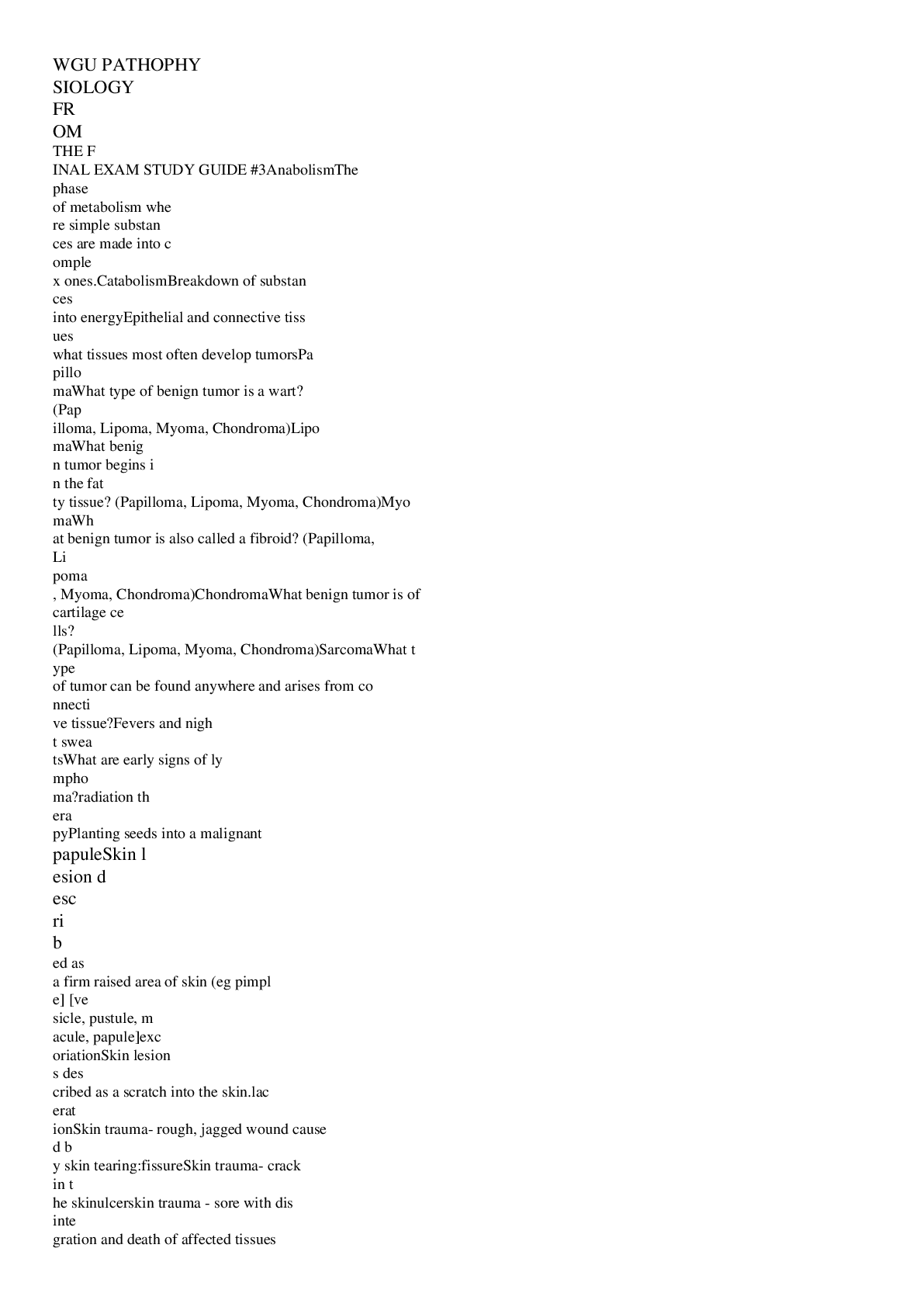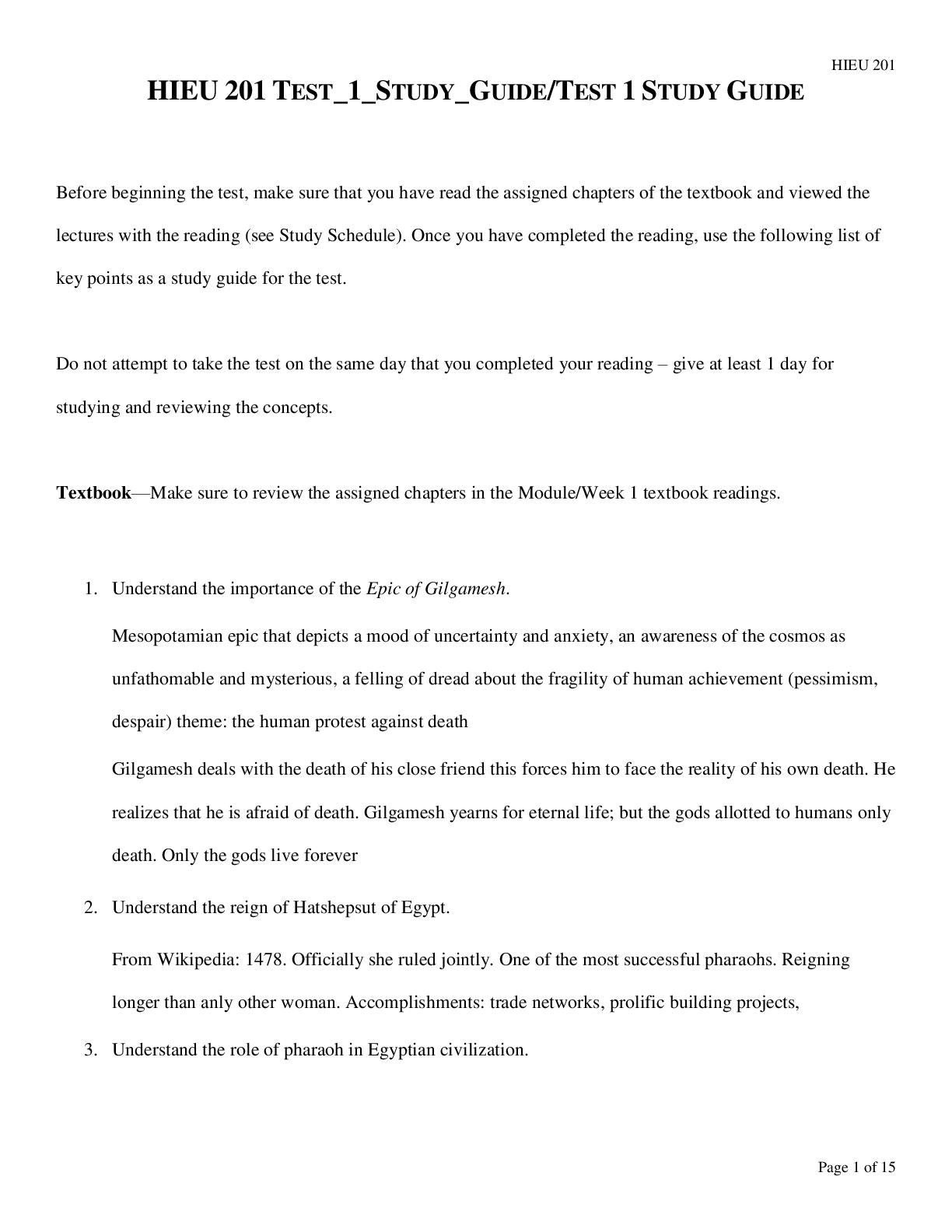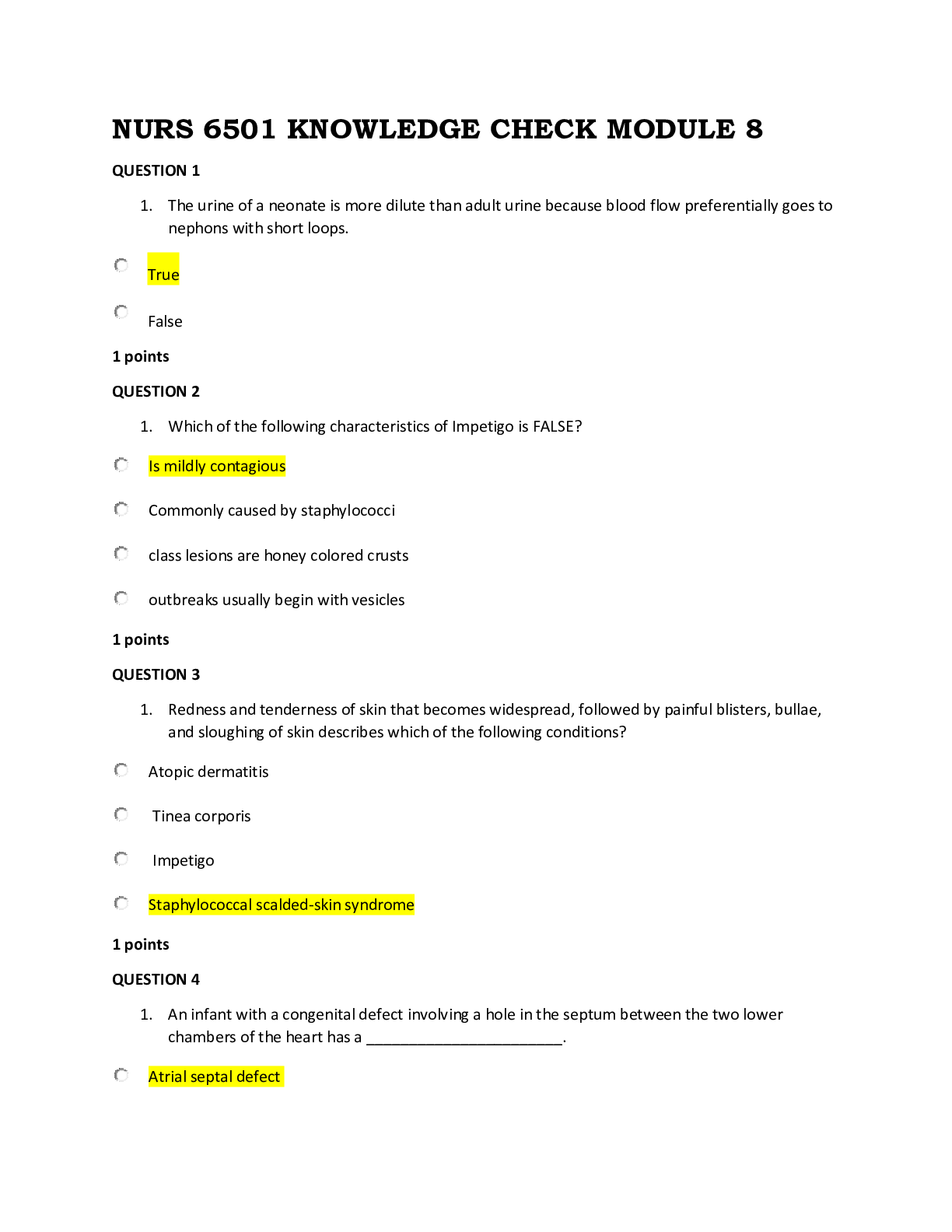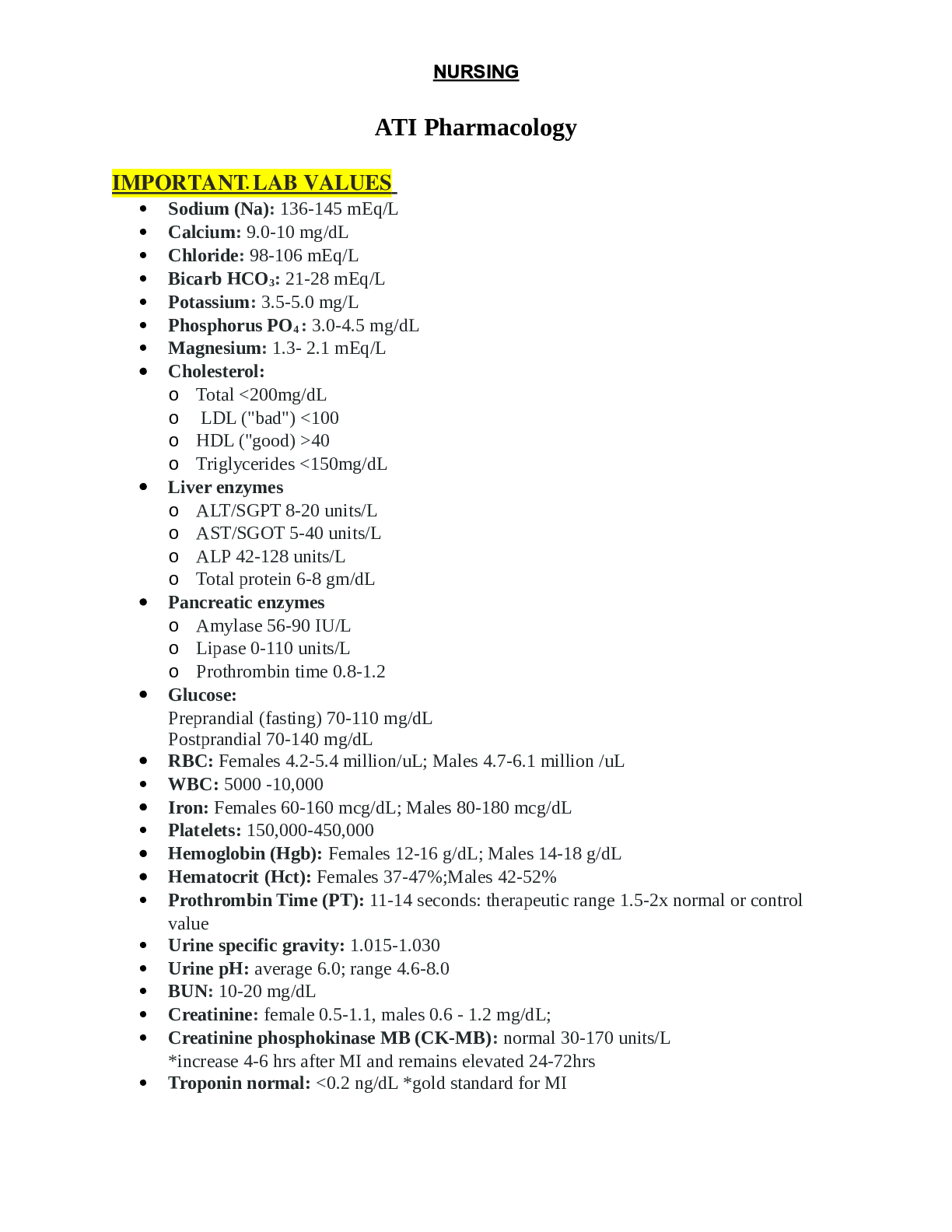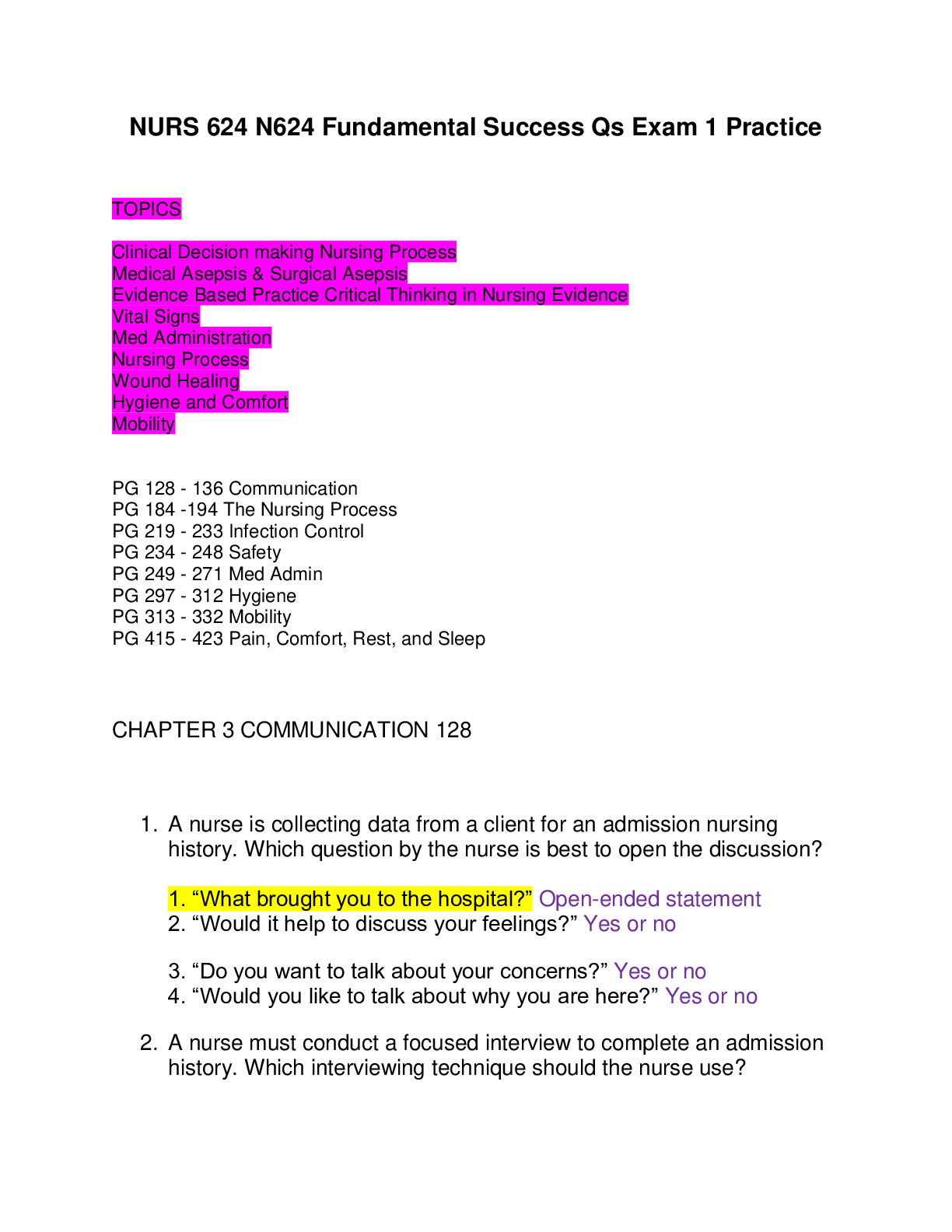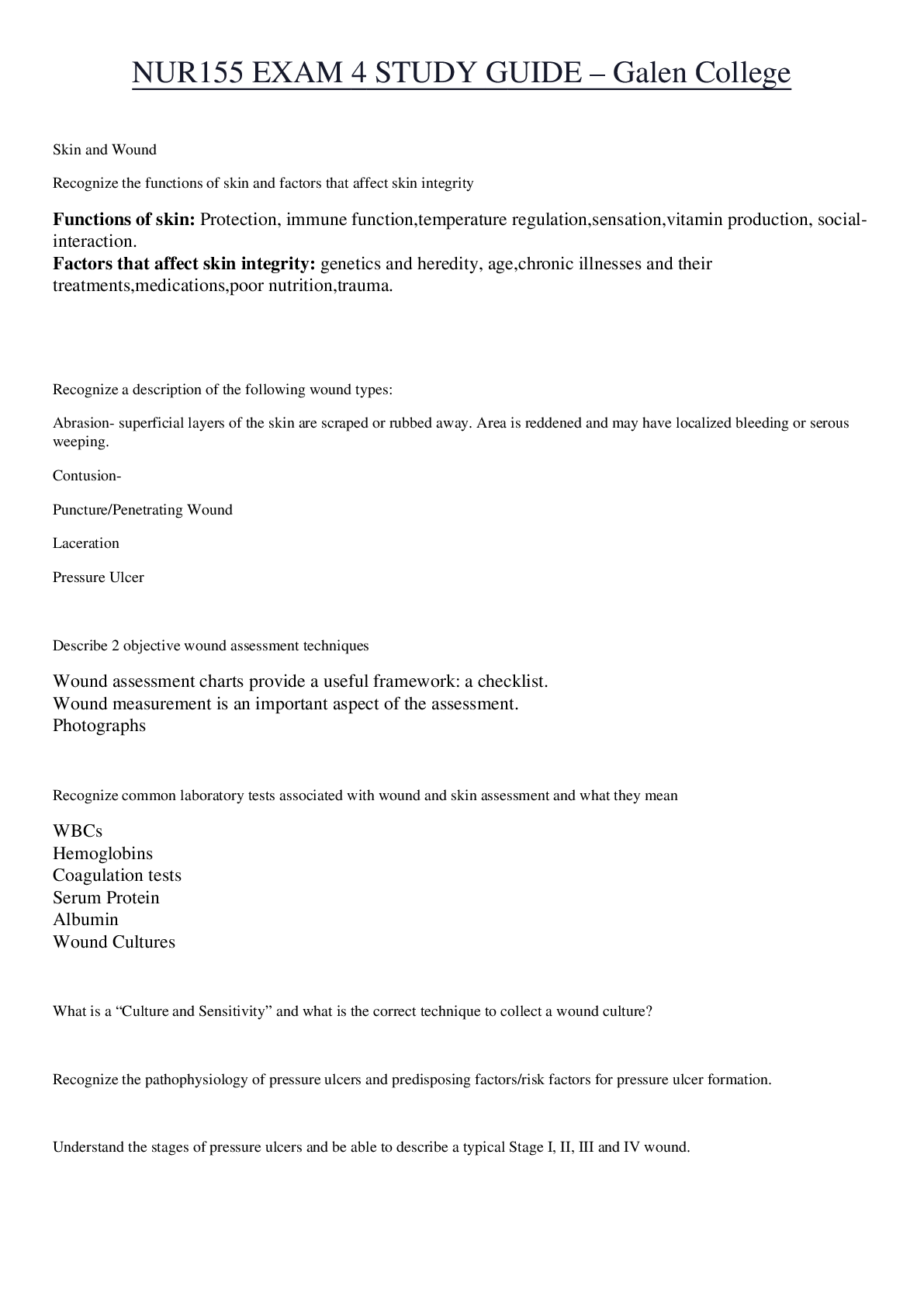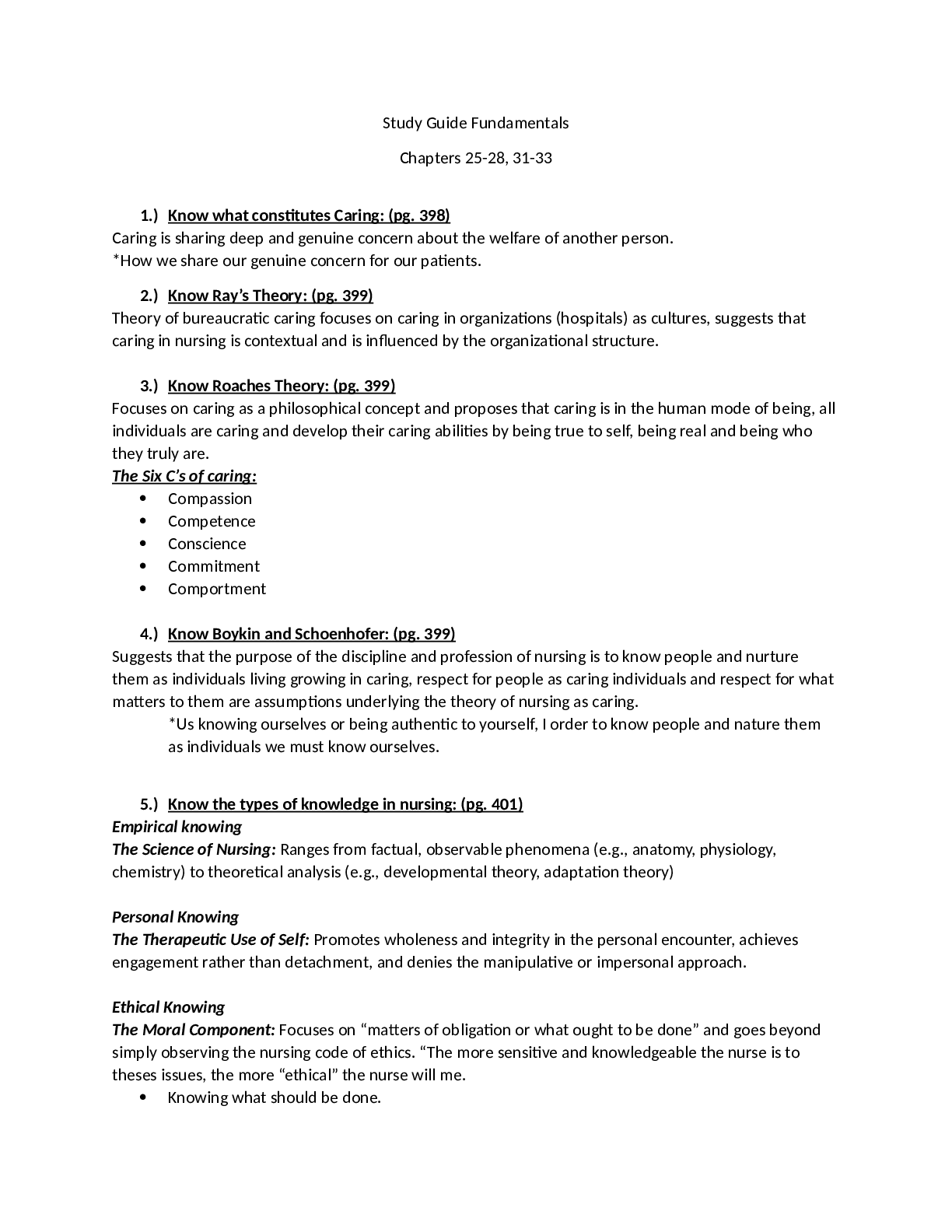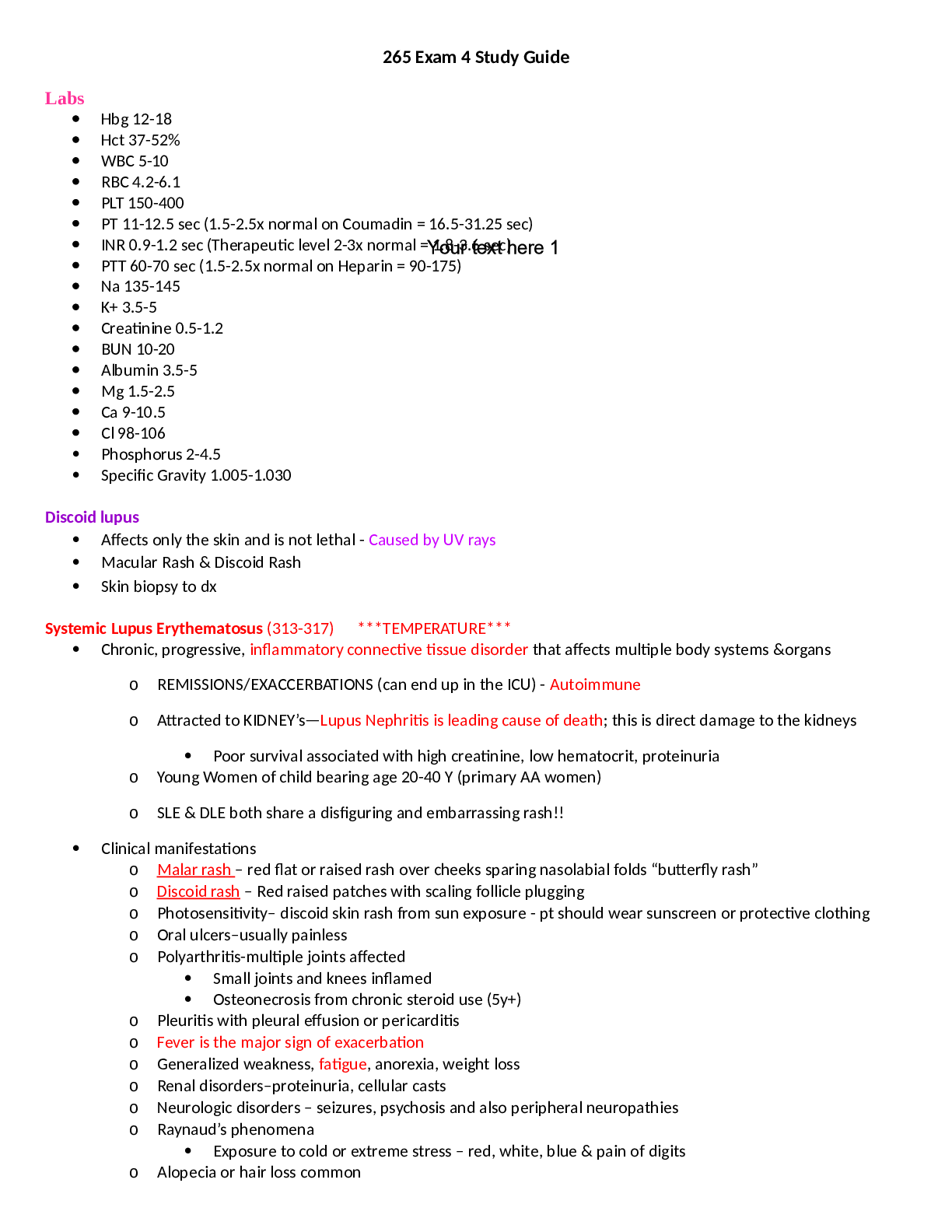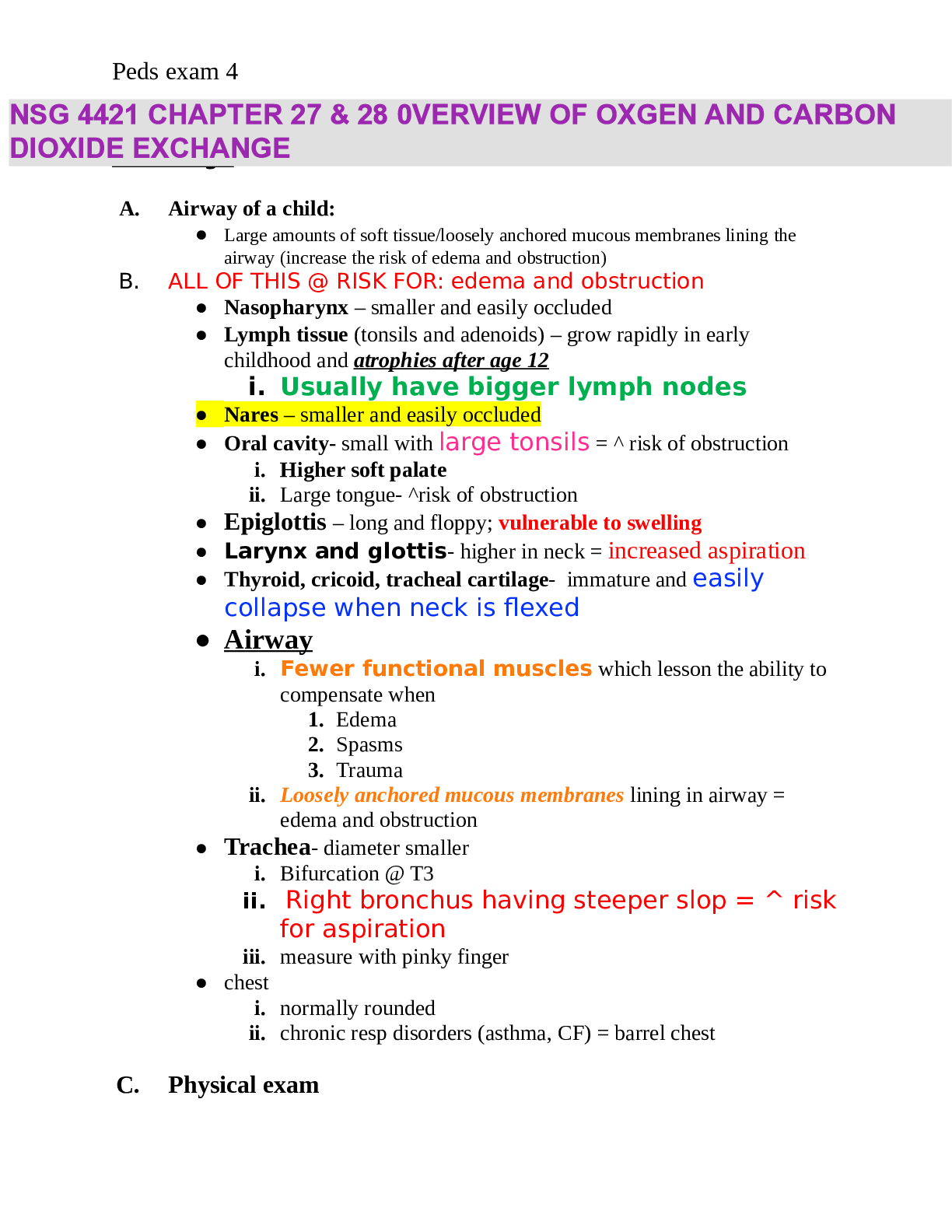Economics > STUDY GUIDE > MANAGEMENT 310A Exam 4 Study Guide Study Guide (All)
MANAGEMENT 310A Exam 4 Study Guide Study Guide
Document Content and Description Below
MANAGEMENT 310A Exam 4 Study Guide Study Guide Management 310A Exam 4 Study Guide Don’t know where it goes: Chapter 13 - Managing Change Forces of change • Some external forces for change... : o globalization o the growing diversity of the workforce o the explosion of the Internet o new legislation o changing customer desires and expectations o heightened levels of competition • Some internal forces for change: o performance gaps o new leadership o a new mission o employee pressures Managing Planned Change Goals: -Improving the ability of the organization to adapt to changes in its environment. -Changing the behavior of individuals and groups in the organization. • Change: making things different • Planned Change: activities that are intentional and goal oriented • Change Agents: persons who act as catalysts and assume the responsibility for managing change activities Forms of Resistance to Change • Overt and immediate o Voicing complaints, engaging in job actions • Implicit and deferred o Loss of employee loyalty and motivation, increased errors or mistakes, increased absenteeism o The Change Process – Lewin’s Change Model Unfreezing the Status Quo Kotter’s 8-Step Change Model • Step 1: Establishing a Sense of Urgency • Step 2: Forming a Powerful Guiding Coalition • Step 3: Creating a Vision • Step 4: Communicating the Vision • Step 5: Empowering Others to Act on the Vision • Step 6: Planning for and Creating Short-Term Wins • Step 7: Consolidating Improvements and Producing Still More Change • Step 8: Institutionalizing New Approaches Sources of Resistance to Change • Uncertainty, Lack of Understanding and Trust, Differing Perceptions, Lack of Tolerance to Change, Rejection of Change Source, Habit, Self-Interest Change Approaches • Education and Communication: Explaining the need for and the logic of the change • Participation and Involvement: Having members participate in the planning and implementation of change • Facilitation and Support: Gradual introduction of the change process and provision of support to people affected by the change • Negotiation and Agreement: Negotiating or bargaining to win acceptance or reduce resistance to change • Manipulation and Co-optation: Covertly steering individuals or groups away from resistance to change • Coercion: Demanding that members support the change or be threatened with the loss Deciding when to use the change Approaches • Education and Communication: Resistance to change is due to lack of information or inaccurate information and analysis • Participation and Involvement: The initiators of change don’t have all the information they need to design the change, and others have considerable power to resist. • Facilitation and Support: People are resisting change because of fear or adjustment problems • Negotiation and Agreement: Someone or some group will clearly lose out in the change and that party has considerable power to resist • Manipulation and Co-optation: Other tactics won’t work or are too expensive Organizational Development (OD) • Organizational development (OD) has been defined as “an effort (1) planned, (2) organization-wide, and (3) managed from the top, to (4) increase organizational effectiveness and health through (5) planned interventions in the organization’s ‘process,’ using behavioral science knowledge.” (507-511) OD Process • Identity a Need of Change • Select a Technique for Change • Gather Top Management Support • Plan the Change Process • Overcome Resistance to Change • Evaluate the Change Process The Learning Organization • According to Peter Senge, in learning organizations “people continually expand their capacity to create the results they truly desire, where new and expansive patterns of thinking are nurtured, where collective aspiration is set free, and where people continually learn how to learn together.” • Learning organizations: develop specific learning capabilities not present in traditional organizations Change Process (489) Freezing and unfreezing/ defressezing Forces of change (486) Look up in Book - Burning platform (499) - Organizational Development - Overcoming Resistance Chapter 14 – Looking Ahead Plan for Ongoing Skills Learning • Coordinate Your Skills, Map and Track Your Skills Portfolio, Develop a Skills Action Plan, Identify Role Models, Use Self-Management for Skill Learning, Practice a lot Seek Varied Assignments • Mobility can take many forms, not just vertical but also radial (toward or away from the “inner circle”) and circumferential (to a different function, program, or product in the organization). • Moves at the same level in the organization can yield fresh perspectives, heightened visibility, and skill-learning opportunities. • Explore options for job rotation, especially to positions that offer the potential to add skills to your portfolio. Work outside Your Job Description • Your job description is not meant as a cage. • Extra-role behaviors are increasingly important in organizations; they are often key to org performance and member satisfaction, and they are likely to be viewed favorably. • Make sure that your boss and others are aware of your interest in learning and be proactive in pursuing skill-enhancing opportunities. • Articulate how your job contributes to the bottom line(s). Continuing Education • Graduate school • Certifications • MOOCs: know what is means, what it stands for and watch: • Massive Open Online Course; but for where information is everywhere, everything is a click away, connects and collaborates, enages, an event. Usually free • https://www.youtube.com/watch?v=eW3gMGqcZQc • Professional journals and trade magazines “Forbes, and Slon” • Professional associations Some Professional Associations • Academy of Management: professional society composed of professors, doctoral students, and consultants • American Management Association (AMA): world’s leading membership-based management development organization • American Society for Training and Development (ASTD): world’s premier professional association and leading resource on workplace learning and performance issues • Society for Industrial and Organizational Psychology (SIOP): its goal is to promote human welfare through the various applications of psychology to all types of organizations • Society for Human Resource Management (SHRM): world’s largest human resource management association • WorldatWork: global not-for-profit professional association dedicated to knowledge leadership in disciplines associated with attracting, retaining, and motivating employees. Summary and Implications • Learning should be a lifelong enterprise. • Update your skills and reflect them in your portfolios, resumes, and interviews. • Consider additional education. • Benchmark, join professional associations, and read widely to stay current on best practices. Look up in Book - Read 532 through 536 Chapter 15 – HR Management What is Job Analysis? • Systematic procedures for identifying information about a job. • Results in job description • Results in job specification (558) • On the job training (learn by doing), off the job training ( learn from course) How is Job Analysis Done? • Sources of information: written material, direct observation, interviews, structured questionnaires Selection Methods • References • Work Sample Tests/Assessment Centers (Hand on Simulation) • Physical Tests • Written Tests • Drug Tests • Interviews Improving Interview Quality • Use multiple interviewers (but be aware of anxiety) • Create an interview protocol • Establish rapport • Ask structured, behavioral questions tied to job duties and KSAs • Give a realistic job preview • Give a chance to ask questions • Review interview immediately after Develop an overall interviewing Strategy • Most of you are applicants rather than hiring managers right now. Be ready for questions like those on the previous slide. • What about yourself do you want the interviewer(s) to know? 3-5 best KSAs for this position. • KSA: Knowledge, Skills, Ability • What disadvantages or weaknesses do you need to minimize? • What do you need to know about the job and the organization to decide whether to accept this job if it is offered to you? Training and Development Programs • Basic Literacy Skills, Technical Skills, Interpersonal Skills, Problem Solving Skills Training: Needs Assessment • Most important step in developing training (which is why premade training programs so often miss the mark) • Assessment from 3 levels of analysis: o Organizational analysis o Person analysis o Task analysis Training Methods • Presentation Mediums • Hands-on Techniques • Team-building Exercises Training Delivery Tips • Describe training objectives • Use employees’ experiences • Give opportunities to practice skills • Provide feedback Performance Evaluation • Why Managers Are Reluctant to Give Feedback o Uncomfortable discussing performance weaknesses directly with employees. o Employees tend to become defensive when their weaknesses are discussed. o Employees tend to have an inflated assessment of their own performance. • Create a feedback-seeking culture • Feedback as a “gas gauge” • Give informal feedback regularly • Use evaluation as a career development opportunity • Set SMART goals for performance Suggestions for Improving Performance Evaluations • Use multiple evaluators to overcome rater biases • Evaluate selectively based on evaluator competence • Train evaluators to improve rater accuracy • Provide employees with due process 360-Degree Evaluations The primary objective of the 360-degree performance evaluation is to pool feedback from all of the employee’s “customers. - SWOTT analyzes the differences of a team vs a company and vs. for yourself Summary and Implications for Managers • Job Analysis: Helps with selection, training and development, and performance evaluation and legal defensibility of all of these processes • Selection Practices: Properly designed selection practices will identify competent candidates and accurately match them to the job. • Training and Development Programs: Improves both performance and motivation • Performance Evaluation: Effective evaluations will help motivate employees and provide career development as well as help make reward allocation decisions. - Bundling: Combining one or more goals, to achieve efficiency - validity: that it measures what its supposed to measure - Where not lazy, were EXHAUSTED!! - Where Professional find advice for new ideas “Forbes, and Slon” Look up in Book - Human resource planning (558) - Job specification (558) - Hand-on simulation: highlighted above - Handyman-learn on job - KSA : highlighted above - Chapter 16 – Balancing Work and Life Dr. G’s five step model KNOW THE ORDER, what each step is, and examples of each. Step 1 - Identify Priorities o Think strategically about your personal life as well as your career life. o Identify what success means to YOU. o Priorities may change, so be sure to periodically reevaluate. How and why managers help employees with Step 1 • It’s worth it for you to do so because it will pay off in trust, loyalty, motivation, and decreased turnover. • Suggest and support employees who go through this process. • Consider organizational policies and procedures for their impact on work life balance. • Conduct a work life audit in your organization. Step 2 - Set Goals o Use SMART criteria o Set sound career goals o Set sound personal goals How and why managers help employees with Step 1 • Create flexible work options • Consider offering benefits for part-time workers • Create off-ramps and on-ramps for those seeking family leave • Create career planning seminars and workshops Step 3 - Assess the present • Use SWOT Analysis • Assess Time Use Step 4 - Make and take action Plans • personalize success • set boundaries • manage time • seek personal outsourcing • seek personal and work life mentors and be a work life mentor yourself Step 5 - Evaluate the results • Ask someone to help create accountability. • Reinforce yourself for success. • Pass it forward: Be a work life role model and mentor. Summing It All Up: Integrative Leadership • Integrative leaders promote balance, connection, transformation, and meaningful accomplishment • They make thoughtful, proactive, ethical, long-term decisions and help others do the same • They walk the walk and don’t just talk the talk • They set SMART goals and provide information • They praise, coach, empower, and mentor their employees and treat them as whole beings • They maximize team and org level policies and practices Read Book - Study all slides [Show More]
Last updated: 2 years ago
Preview 1 out of 8 pages
.png)
Buy this document to get the full access instantly
Instant Download Access after purchase
Buy NowInstant download
We Accept:

Reviews( 0 )
$8.00
Can't find what you want? Try our AI powered Search
Document information
Connected school, study & course
About the document
Uploaded On
Mar 13, 2021
Number of pages
8
Written in
Additional information
This document has been written for:
Uploaded
Mar 13, 2021
Downloads
0
Views
84

